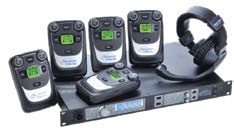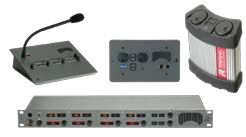
Digital Party-Line
With the advances in networking technology and digital audio processing, a new generation of digital party-line systems has recently become available.
Combining the traditional formats of rack-mounted 4-channel base stations and connected beltpacks with a digital data stream, they offer four duplex channels on a single pair of wire and the choice at the beltpack to talk/listen on any two of those channels.
Connections can be made with microphone cable, CAT-5, or even an existing run of twisted pair. Base stations can support dozens of beltpacks, and allow interfacing to analog or digital wireless intercom, as well as digital matrix and IP-based intercom systems.

Beltpacks can be daisy-chained or have separate runs via splitters, and can accept program inputs if desired for monitoring the event.
These new digital intercom systems can be configured either via the hardware itself (LCD displays and menus), or through software tools and a network connection. Feature upgrades can be accomplished digitally, is some cases using the USB connection on the beltpack.
Digital Matrix
Digital matrix systems allow the voice levels of the individual keys to be controlled at the stations, giving each user an individual audio mix.
They consist of: (a) central communications frames through which all communications and data are routed; (b) multi-key intercom stations that allow many channels of communication; and (c) interfaces to other systems such as telephones, 2-way radios, a party-line or wireless intercom, audio and IFB/cue systems, plus links and relays to control other devices.

These systems are fully programmable so that any type of point-to-point, group or party-line communication can be created, and any or all of these configurations can be accessed by each user station.
The central communications frame contains several multi-port circuit-board cards that process and route audio signals and control data coming from the individual stations and interfaces.
Frame sizes with differing capacities vary from 1 RU to 8 RU, Each station and interface connects to the frame via a port, such as an RJ-45 connector, with paths for audio signals and control data.
The stations typically offer between 4 and 32 keys each, and are often expandable. No matter how many individual keys are used, the stations connect to the central communications frame via a single 4-pair cable for analog transmission or single-pair or coaxial cable for digital transmission.

Virtual panels on computers are also possible with matrix systems, with their presentation and actions usually emulating physical stations.
Digital matrix intercom systems are ideal for complex communications applications. They allow many channels and types of communication to be combined into a single, integrated system.
Because these systems are flexible and programmable, they can be adapted to work in a variety of situations, from a television news studio to a large performance venue to controlling a rocket launch. Real-time signal routing changes can be made without moving any cables.
Sophisticated interfacing capabilities make digital matrix intercom systems the choice for communicating among distant facilities, and they make it easy for distant users on a telephone, cell phone or two-way radio to participate in the conversation.
Digital matrix systems can route multiple sources of program audio, create as many cue channels as desired, and control external devices such as lights and monitor levels via relays.
